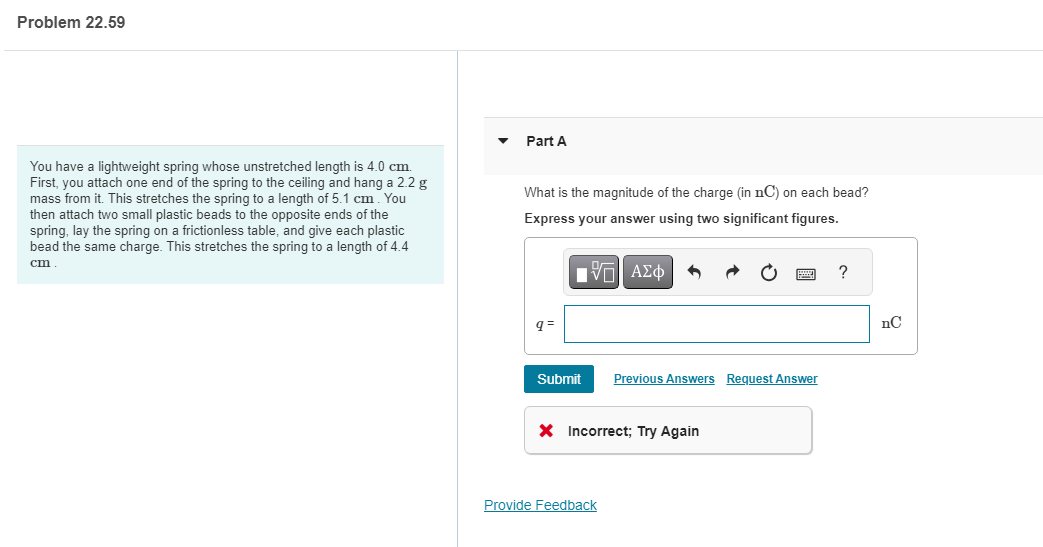You have a lightweight spring whose unstretched length is 4.0 cm. First, you attach one end of the spring to the ceiling and hang a 2.2 g mass from it. This stretches the spring to a length of 5.1 cm. You then attach two small plastic beads to the opposite ends of the spring, lay the spring on a frictionless table, and give each plastic bead the same charge. This stretches the spring to a length of 4.4 cm ▼ Part A What is the magnitude of the charge (in nC) on each bead? Express your answer using two significant figures. VG| ΑΣΦ q= Submit Previous Answers Request Answer X Incorrect; Try Again Provide Feedback ? nC
You have a lightweight spring whose unstretched length is 4.0 cm. First, you attach one end of the spring to the ceiling and hang a 2.2 g mass from it. This stretches the spring to a length of 5.1 cm. You then attach two small plastic beads to the opposite ends of the spring, lay the spring on a frictionless table, and give each plastic bead the same charge. This stretches the spring to a length of 4.4 cm ▼ Part A What is the magnitude of the charge (in nC) on each bead? Express your answer using two significant figures. VG| ΑΣΦ q= Submit Previous Answers Request Answer X Incorrect; Try Again Provide Feedback ? nC
Principles of Physics: A Calculus-Based Text
5th Edition
ISBN:9781133104261
Author:Raymond A. Serway, John W. Jewett
Publisher:Raymond A. Serway, John W. Jewett
Chapter19: Electric Forces And Electric Fields
Section: Chapter Questions
Problem 69P
Related questions
Question
100%
Please asap

Transcribed Image Text:Problem 22.59
You have a lightweight spring whose unstretched length is 4.0 cm.
First, you attach one end of the spring to the ceiling and hang a 2.2 g
mass from it. This stretches the spring to a length of 5.1 cm. You
then attach two small plastic beads to the opposite ends of the
spring, lay the spring on a frictionless table, and give each plastic
bead the same charge. This stretches the spring to a length of 4.4
cm
Part A
What is the magnitude of the charge (in nC) on each bead?
Express your answer using two significant figures.
ΠΑΠ ΑΣΦ
q=
Submit Previous Answers Request Answer
X Incorrect; Try Again
Provide Feedback
?
nC
Expert Solution
This question has been solved!
Explore an expertly crafted, step-by-step solution for a thorough understanding of key concepts.
This is a popular solution!
Trending now
This is a popular solution!
Step by step
Solved in 4 steps with 4 images

Knowledge Booster
Learn more about
Need a deep-dive on the concept behind this application? Look no further. Learn more about this topic, physics and related others by exploring similar questions and additional content below.Recommended textbooks for you

Principles of Physics: A Calculus-Based Text
Physics
ISBN:
9781133104261
Author:
Raymond A. Serway, John W. Jewett
Publisher:
Cengage Learning

College Physics
Physics
ISBN:
9781305952300
Author:
Raymond A. Serway, Chris Vuille
Publisher:
Cengage Learning

College Physics
Physics
ISBN:
9781938168000
Author:
Paul Peter Urone, Roger Hinrichs
Publisher:
OpenStax College

Principles of Physics: A Calculus-Based Text
Physics
ISBN:
9781133104261
Author:
Raymond A. Serway, John W. Jewett
Publisher:
Cengage Learning

College Physics
Physics
ISBN:
9781305952300
Author:
Raymond A. Serway, Chris Vuille
Publisher:
Cengage Learning

College Physics
Physics
ISBN:
9781938168000
Author:
Paul Peter Urone, Roger Hinrichs
Publisher:
OpenStax College

College Physics
Physics
ISBN:
9781285737027
Author:
Raymond A. Serway, Chris Vuille
Publisher:
Cengage Learning

Physics for Scientists and Engineers, Technology …
Physics
ISBN:
9781305116399
Author:
Raymond A. Serway, John W. Jewett
Publisher:
Cengage Learning

Physics for Scientists and Engineers: Foundations…
Physics
ISBN:
9781133939146
Author:
Katz, Debora M.
Publisher:
Cengage Learning